
Horny Africritters

Blog 15 by Tan (Rhino bit by Mick): Horny Africritters
Our last week in South Africa was beyond rough on us. The 7-day timeline had us dragging our tired and stressed bodies through 3 different countries in what has to have been the hottest, driest week of the trip. Things had been so busy I had no time whatsoever to study for the exam that I was travelling all the way to the British Embassy in Gabarone, Botswana to sit. And in the midst of all this I got the devastating news that my most amazing granddad (the biggest fan of our trip) passed away suddenly.
For the most part riding a bike is a great way to clear one’s mind but speeding along the monotonous roads of the Kalahari instead provided fertile ground for thinking for hours about just how sad I was. Hours and hours straight, crying into my helmet, rushing for the border. It was simple. I was not liking the trip at all at that point. I suppose it had to happen at some time.
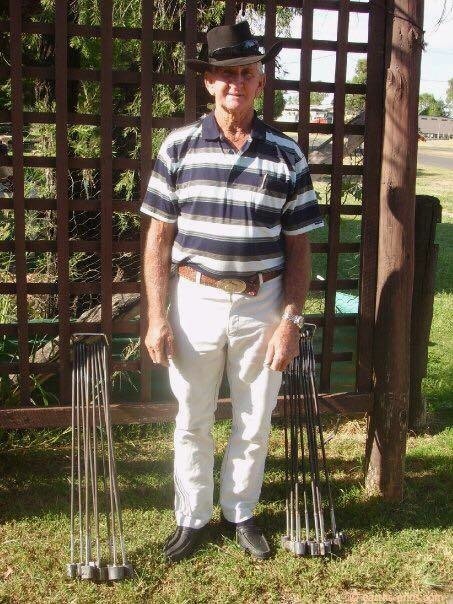
Rex – loved by everyone – ‘No doubt about it’.
After such a long and hot slog to get to the border we were pleased to be met with some friendly Botswana border staff who recommended a place for us to stay for the night. We rode on 260kms to the little town of Tsabong and headed for Berrybush Camp. It was getting toward the end of the day and we were both well and truly destroyed. Arriving at the turnoff for Berrybush Camp we were greeted with 3km of thick sandy bush track to negotiate in our ridiculously fatigued state and on road tyres at road pressures. A nasty little challenge at the end of a long day but we managed it without mishap.
Berrybush Camp with its rugged simplicity and calm was a Godsend in the end. Being the low season we had the place pretty much to ourselves. We stayed on for three nights where we rested, enjoyed the peaceful location, ate wonderful home cooked meals and fell in love with Jill the proprietor. Put simply, she is a legend of a woman. A genuine, loving and tough old lady. She worked harder at 70 than we are likely to ever work at anything. She has led an incredibly interesting life and shared stories with us of the years she had spent living with Kalahari Bushman and the perilous trekking of cattle across the country she had done, among many other impressive feats. She was an instant fan of what we were doing with our round the world trip. Her enthusiasm for our journey served to buoy my spirit at the time when I was not really feeling it.
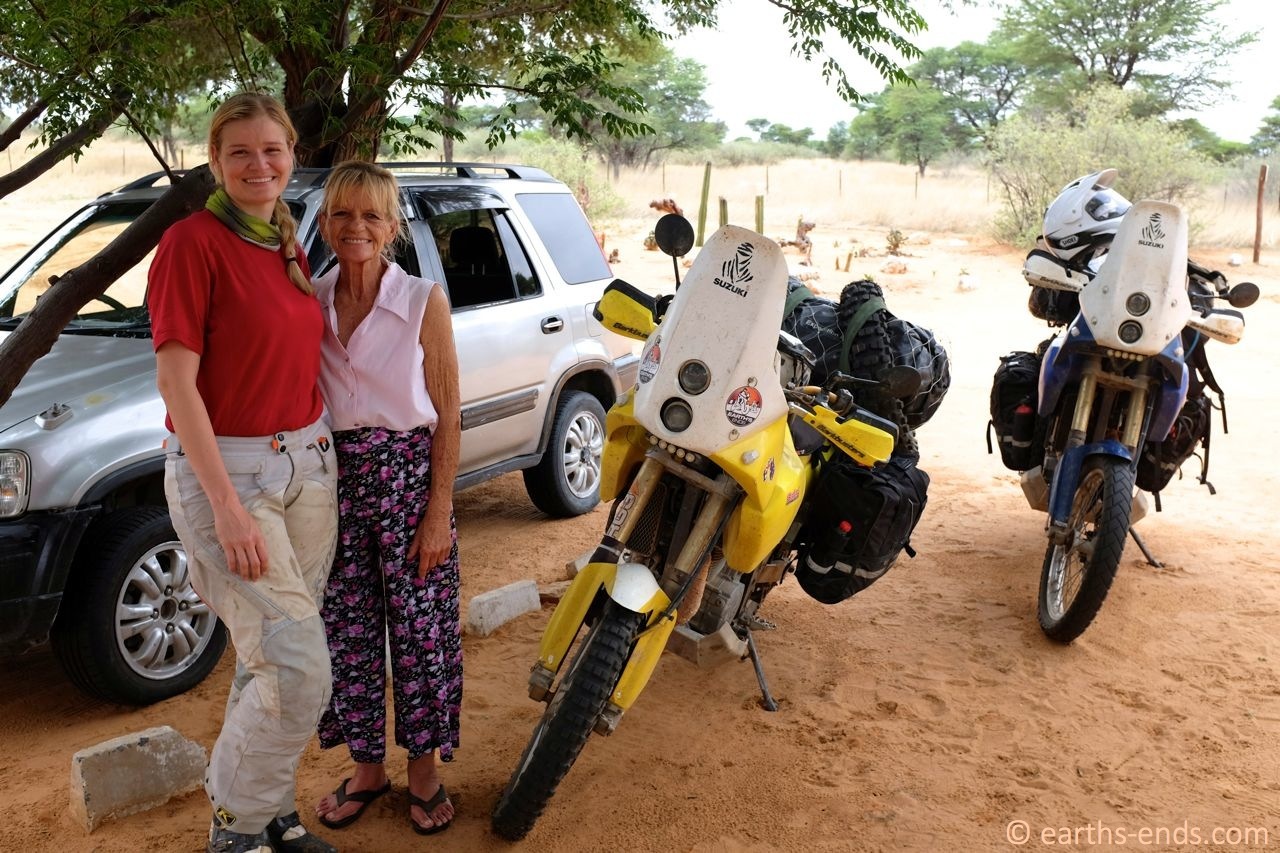
Jill – the kind-hearted and formidable owner of Berrybush Camp
In Jill we had found a kindred spirit and we were sad to be leaving so soon but with the dreaded exam looming we had to be on our way. However that was only after fierce negotiations with Jill over the bill for our stay that she flat out refused to give us. It took us quite some time to realise that we were never going to win against a woman who has come face to face with lions. This trip has been a constant display of the generosity of strangers (that quickly become friends) and the way in which our little motorbiking jaunt engages people. Throughout the trip, over and over again, we have been taken into peoples’ homes, been given free nights accommodation and meals and constant advice and endless good will. We cannot believe how lucky we are to have experienced such kindness so far from home.
The generous support continued when we stopped for food at a service station in a blink and you’ll miss it town called Sekoma. The owner looked like he had his hands full dealing with non-functioning bowsers (quite a problem when trying to sell fuel) but took the time to talk to us and hear our plans. He wanted to know where we were staying when we got to Gabarone and naturally we had no idea yet. He went ahead phoned a place that he knew to be good and told them to expect us late. He also got them to double check that the wifi is working so I could do some last minute study. When we arrived in Gaborone on the eve of the exam, instead of studying we opted go out for dinner and treat ourselves to our first lot of Indian food since our fantastic bunny chow experience in Durban. I figured that if I didn’t know my stuff by now a couple hours of study would be of less benefit to me than a stomach full of butter chicken and mango lassi would be.
The next morning I donned my lucky pair of underwear and we rode in the rain to the British Council at the British High Commission in the centre of town. The lady there kindly informed me 10 minutes before the exam was to start that there had been a location change as they were renovating and that they had no way to inform me. Luckily they arranged for one of their employees to immediately drive me to the new location (the Botswana National Productivity Centre – love it) and I managed to arrive right on time and smashed out the exam. I was happy to find out later that I aced it and the subject as a whole, which made all the effort and inconvenience of studying while on the road worth it.
I had a pretty idealised view of Gaborone having been a long time fan of the No. 1 Ladies Detective Agency book series where the city of Gaborone features prominently in the quaint detective exploits of Precious Ramotswe. The real Gaborone is far busier, modern and larger than the books suggest and we were surprised to see that, for an African capital, it was pretty neat and orderly. Another pleasant surprise was the openness of the people. Whenever we stopped somewhere people didn’t hesitate to chat with us and ask us about our journey and impressions of Botswana.
Gradually we made our way north to the Khama Rhino Sanctuary for a couple days of camping and rhino stalking. Now, most of the time I would say that riding motorbikes beats driving a car in Africa but where that argument falls down is when we go to places like the rhino sanctuary and cannot ride around the park due to the danger of wild animals. At this point we have to pay for a tour. That in itself is ok when considering some of these parks have some pretty scary animals who might well mistake the DRs for a sick lumbering beast worthy of attacking. However, at this place we had to pay a vehicle fee per bike for each day in the park but we were only permitted to ride from the gate to the campsite. We were paying the same price as a car of up to 1.5 tonnes for each bike to sit in the campground located a km or so from the front gate. It made for some pretty expensive camping.
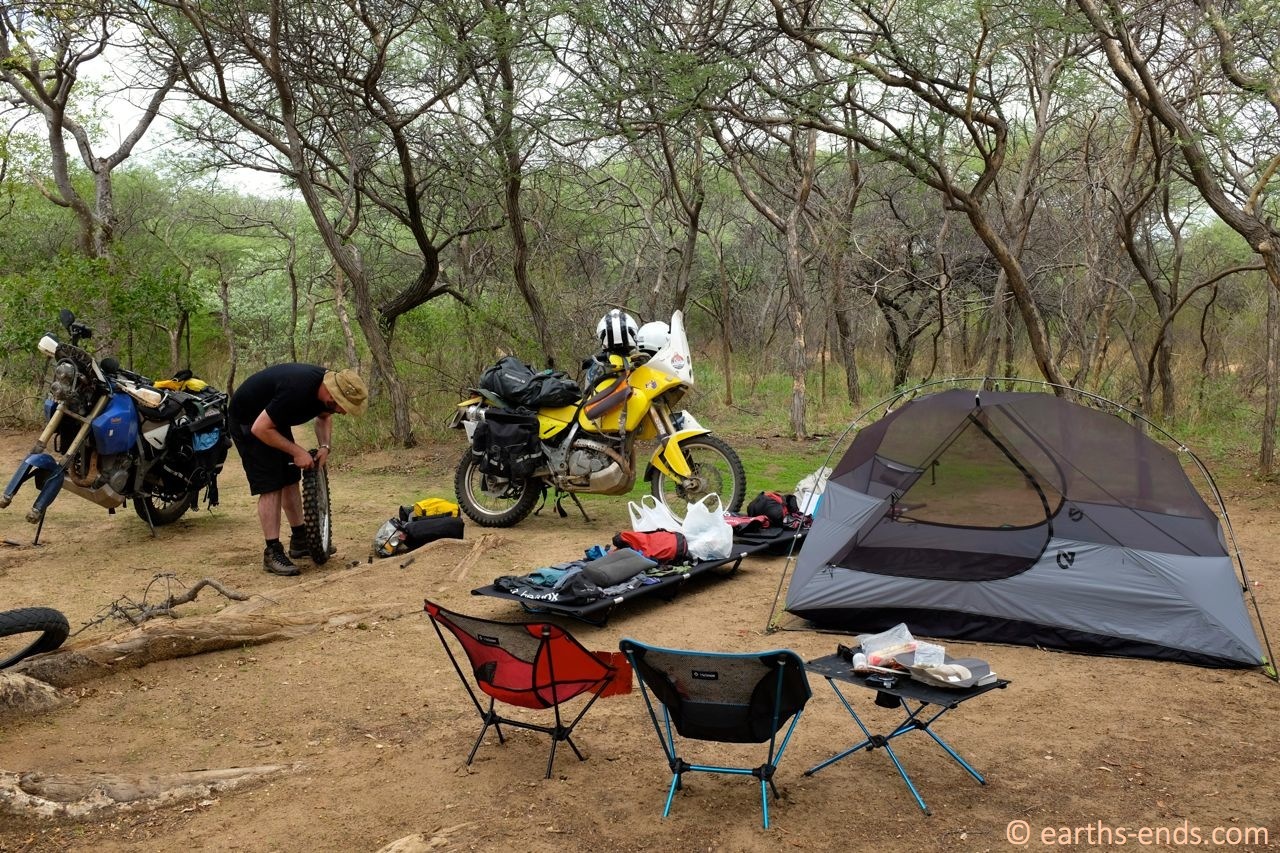
While chilling out in the cam ground Michael did a bit of maintenance
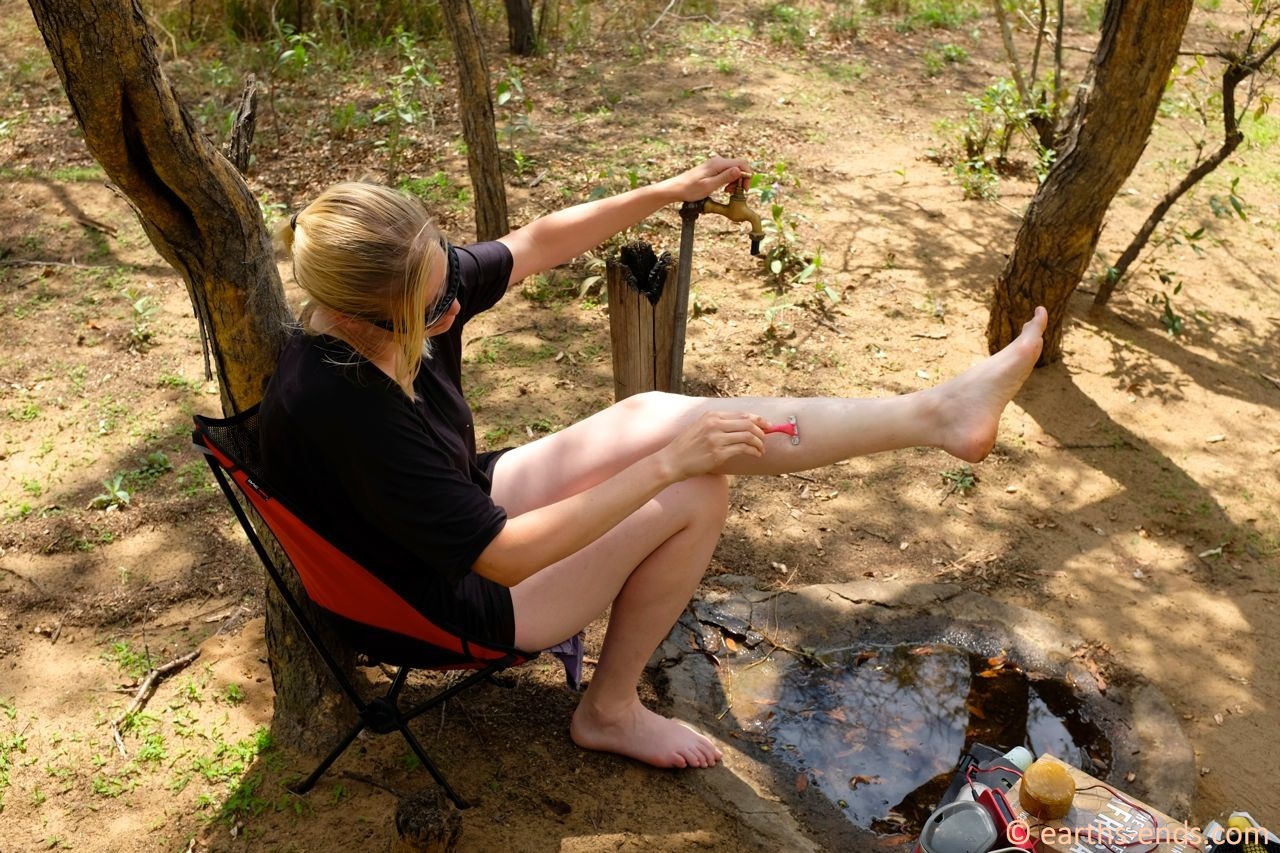
So did I
I think motorbike tourism is probably the best form of tourism around as we biker folk, with our limited space, by necessity spread a trickle of money the whole way along the journey, putting money in more pockets than conventional tours or travel by car. With a car you can stock the thing with food, water and supplies to last a week between visits to the supermarket if needs be. On the bike we spend money every few hours as we can’t carry much or keep anything cold. Beyond tuna and crackers we can’t prepare lunch for ourselves on the road and often by dinnertime we are too exhausted to cook and clean up, so generally pay for dinner too. It would be great to see Africa become more of a motorbike tourism location but for that to happen places need to cater to bikes more. I.e. not charge $10 per bike, per day to sit in a campground. Rant complete!
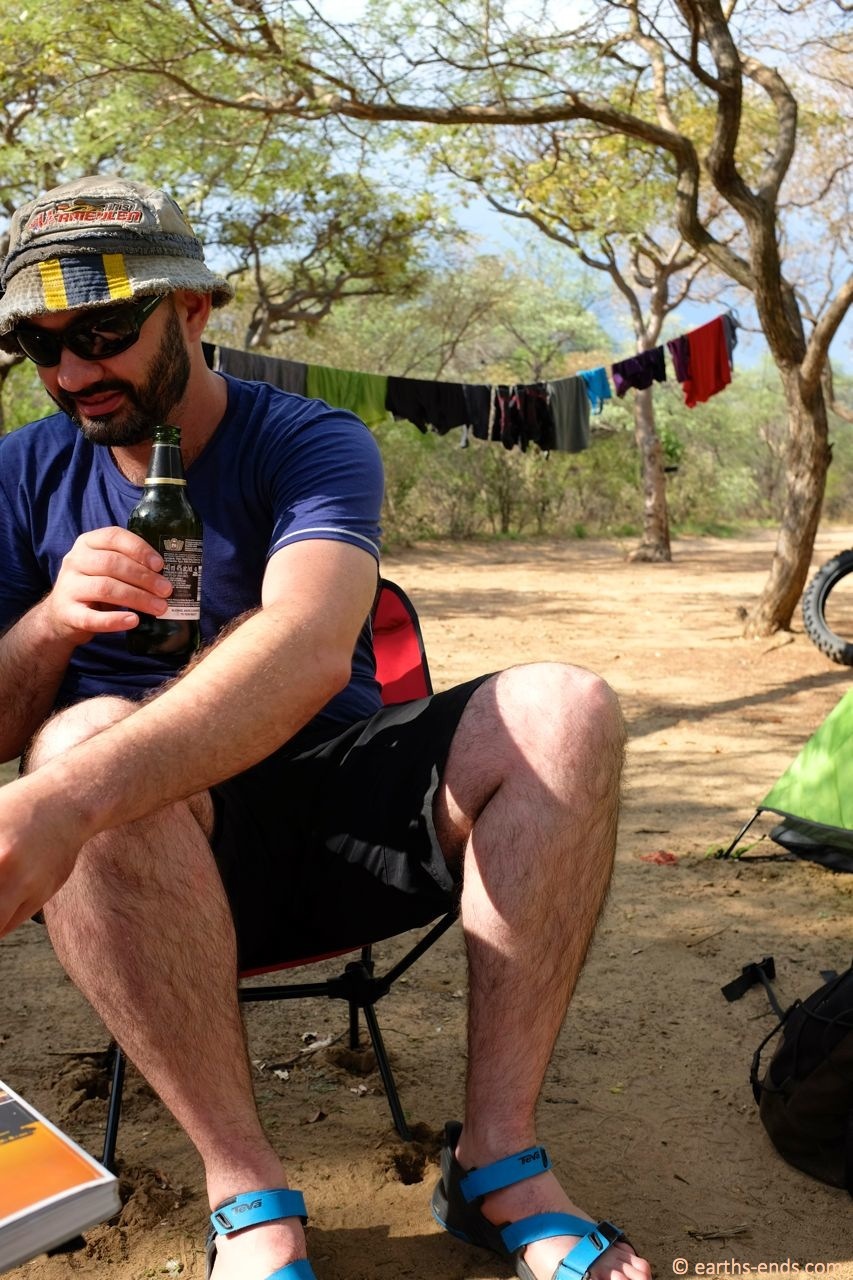
A Windhoek draft after the completion of chores
While at the rhino sanctuary we lined up an early morning game walk. It was just the two of us and two guides who seemed to know what they were doing which was encouraging. Even more encouraging was that they brought a rifle along with real bullets incase things went pear shaped. We drove until we found some fresh rhino tracks and started following them into the bush. The guys soon found some very fresh rhino urine so we knew we were close and before long we were able to see the party of three white rhinos through the scrub. We got very close but even with their poor vision, they knew we were there and we could hear them snorting and running around to try and see what was near them. When these guys move it is rather scary as with each step you get a real sense of the massive weight and power they have behind them. We kept following them and gradually got within 20m when they eventually got scared and ran off. It was all pretty intense and a lot more interactive than sitting in a Landcruiser. Having said that I think I will be sticking with the 4 wheeled enclosed cabin transport options from now on. I don’t like my chances against any of the animals they have over here.
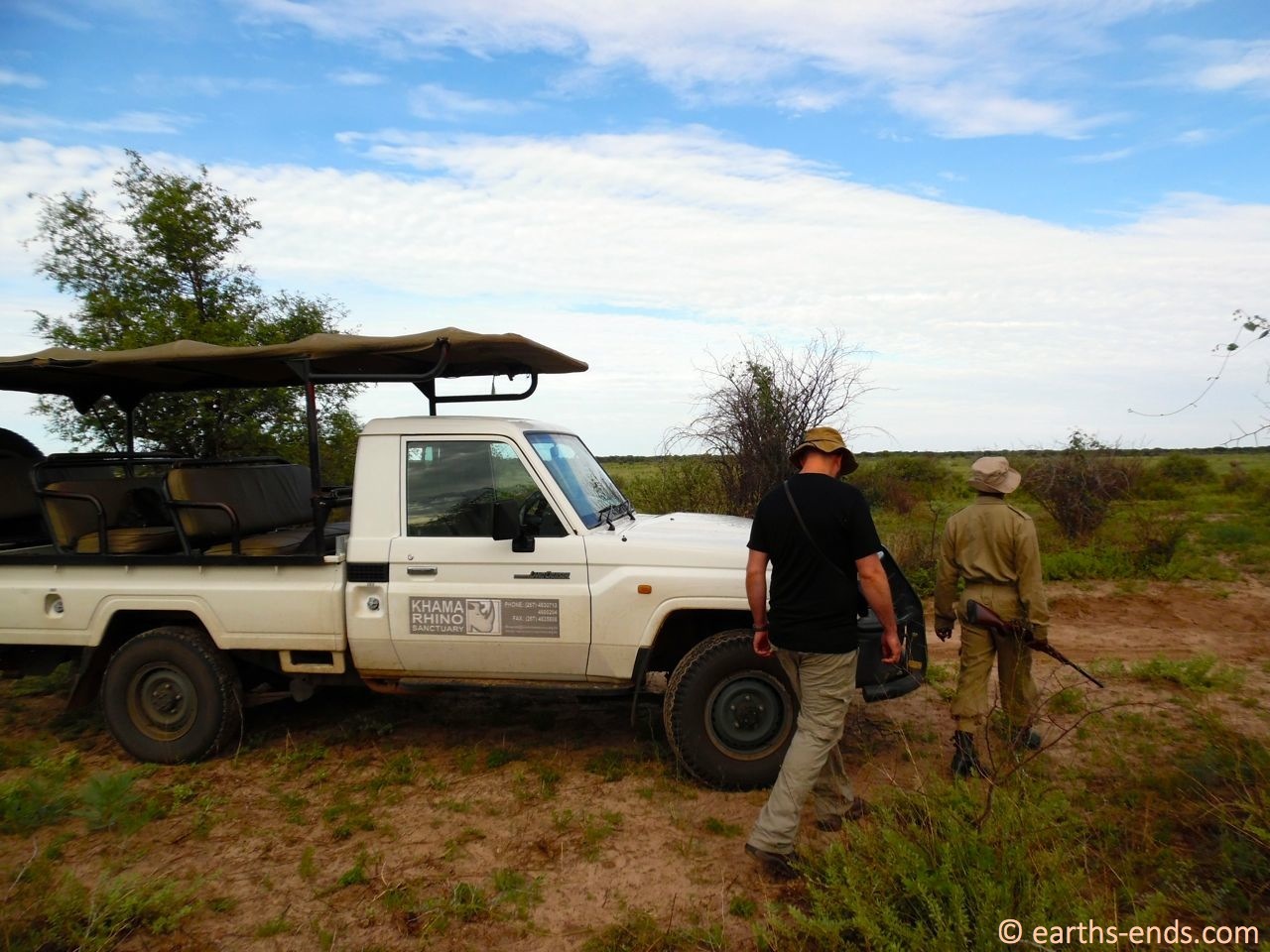
Looking for rhinos
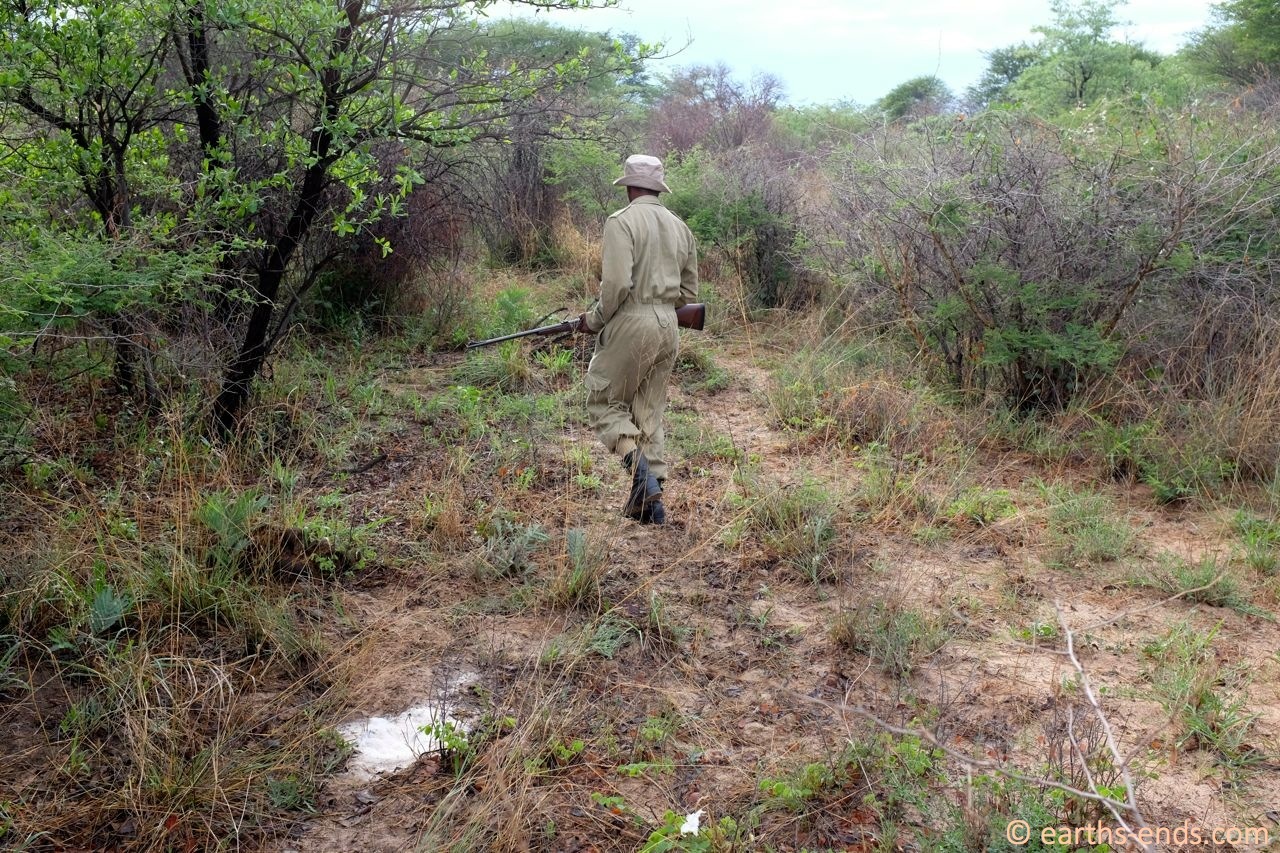
Hot on the trail
After that we did a quick spin around the game park in the Landcruiser where we saw a heap more animals such as wildebeast, hartebeast, springbok, impala, warthog, ostrich, zebra, bustard and quite a few rhino. We were lucky enough to see a very old female and her still quite young baby. We also got to witness an enormous male get chased off by a large but not nearly as enormous female who was protecting her baby. When she charged at him and whacked him, their horns clashed making the most awe inspiring cracking sound.

Lady impala
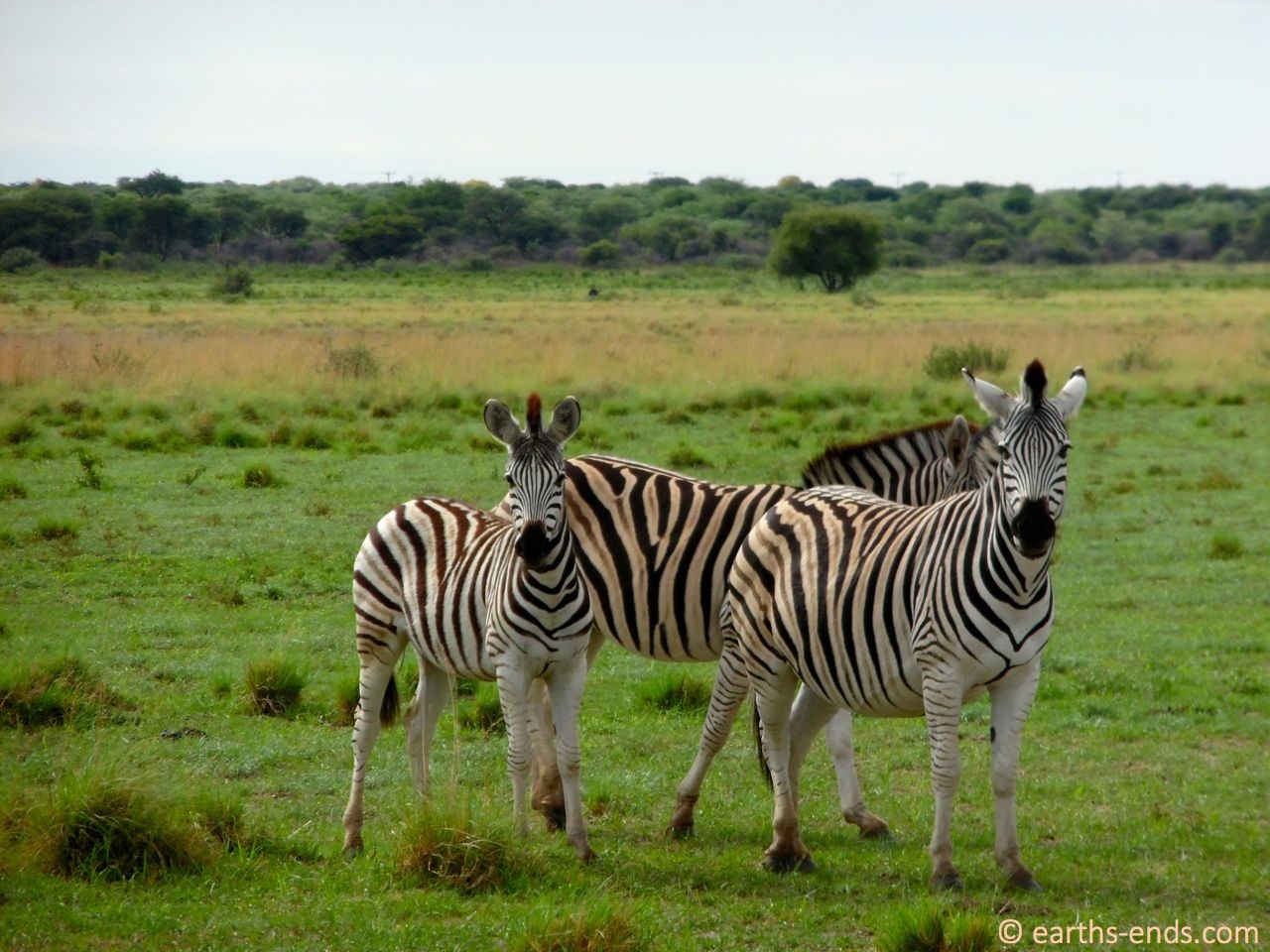
Zebra
What makes the old rhinos so special is that their horn is not a bone, its more like a finger nail (and its made of exactly the same stuff: keratin), so its not attached to the animals skeleton and it never stops growing. If left alone (i.e. not poached) the horn will just keep growing and growing until the rhino dies of old age, which is around 40 years old. With a 16 month gestation period and then at least 18 months of suckling, it means that a mature female can only produce about 10 babies in its lifetime. That is if its not poached for its horn, which is used in traditional Chinese medicine for many purposes except growing boners; interestingly its use as an aphrodisiac by the Chinese is a myth spread in western media.

The backsides of a mother rhino and her baby
So while using rhino horn its not so uplifting as we would love to believe, apparently the keratin that comes from rhino horn will cure everything else that ever affected man kind EVER; from nose bleeds, strokes, convulsions and fevers to hallucinations and bewitching nightmares. Also treats typhoid, headache, and feverish colds. Its good for carbuncles and boils full of pus. Also for intermittent fevers with delirium. And if needed, it will expel fear and anxiety, calm the liver and clear the vision. And if that doesn’t sell you on it, continuous administration lightens the body and makes one very robust. Oh, and here are a few more treatments; dysentery, violent vomiting, food poisoning, poisonous drug overdose, snake bite, arthritis, melancholia, loss of the voice, hematemesis (throat hemorrhage), rectal bleeding, and heavy smallpox. And the best one yet, it will cure devil possession and keep away all evil spirits and miasmas. Considering what it can do, I’m surprised it can’t manage a simple erection. Unfortunately the keratin that comes from your fingernails doesn’t do any of these things (stiffies included I would assume), it’s only the supernatural keratin from rhino horn that has these magical medicinal powers. Ahem.
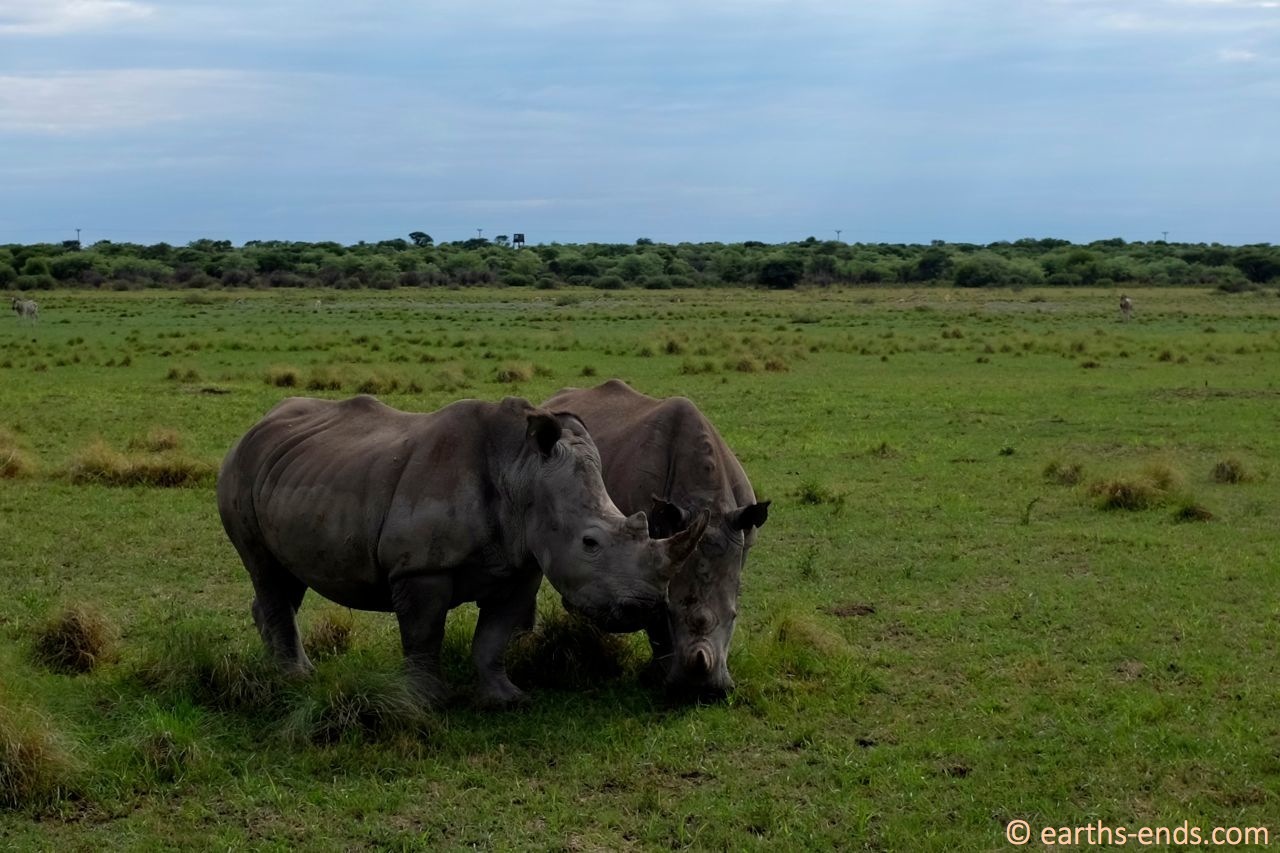
A couple of white rhinos. Unfortunately we didn’t see any black rhinos

Another pair of rhino
Black rhinos are considered “critically endangered” by the International Union for Conservation of Nature (IUCN), and wildlife experts estimate that only 4,240 black rhinos remain in the wild. White rhinos are classified as “near-threatened,” and there are an estimated 20,150 white rhinos in the wild. In 2013, 1004 rhinos were killed in South Africa. Kruger National Park, which is home to South Africa’s largest population of rhinos (both black and white), was hardest hit, with poachers killing 606 rhinos within the NP. Figures just released state that 1215 South African rhinos were poached in 2014. You don’t need to be sum mafs geni-arse to see that rhinos will be soon completely gone from the wild.
Ok everyone – this is a controversial opinion warning. I appreciate that this is a very sensitive topic and some people will not agree with us, but please hear us out.
Due to the scale of the problem and the rapidly reducing time left to solve it, legalising rhino horn production and farming rhinos is being discussed here in Southern Africa as a potential solution. It’s a gruesome thought, however it has significant merit. If rhino horn were legalised and regulated, there would be incentive to keep rhinos alive as they continue to grow their horn their entire life. Whereas poachers at the moment simply kill the animal because they have to, if it were a commercial farming operation a female could produce 10 babies and have its horn harvested 3 times in a lifetime. As pathetic and ridiculous as using rhino horn as a medicine is, the industry is not going anywhere, certainly not for a few generations of Chinese (overwhelming to principal consumers) to be change their habits. Even if demand was eliminated in one generation, rhinos will be soon extinct unless something drastic changes.
Ok, end of controversial opinion piece. That’s one paragraph discussing a massive issue with many pros and many cons. Normal programming resuming….. now!
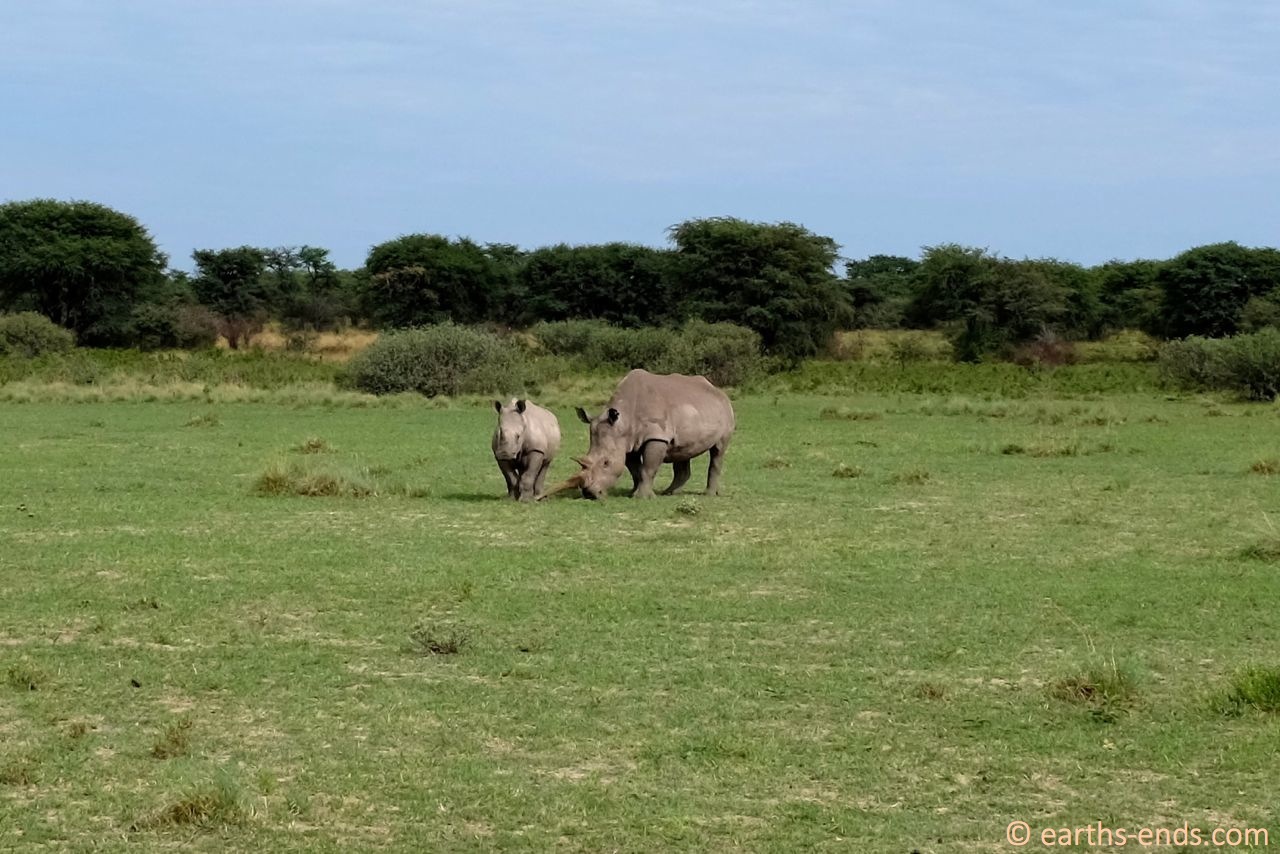
The oldest rhino in the park, a mother and her baby. The long, straight horn is a sign of her advanced age
After our time with the rhinos it was time to spend some time with elephants we thought. We had heard of this great campsite called Elephants Sands from another Overlander couple we met all the way back in South Africa. Not knowing anything more about the place we rocked up with the hope of seeing some elephants. Within a few hundred metres of the highway turnoff to the campsite we did just that. It was rather incredible that we managed to stay on the bikes in all the excitement of getting spitting distance of wild elephants while riding through the thick, soft sand. I think we knew the stakes were high with there being some baby elephants in the mix. Dropping the bike was potentially a big problem as there is no way would could out ran an angry elephant. With all our riding gear on we can run about as fast as if we were wearing 4-inch stilettos. Fortunately the elephants seemed relaxed enough and not all that concerned that we were there.
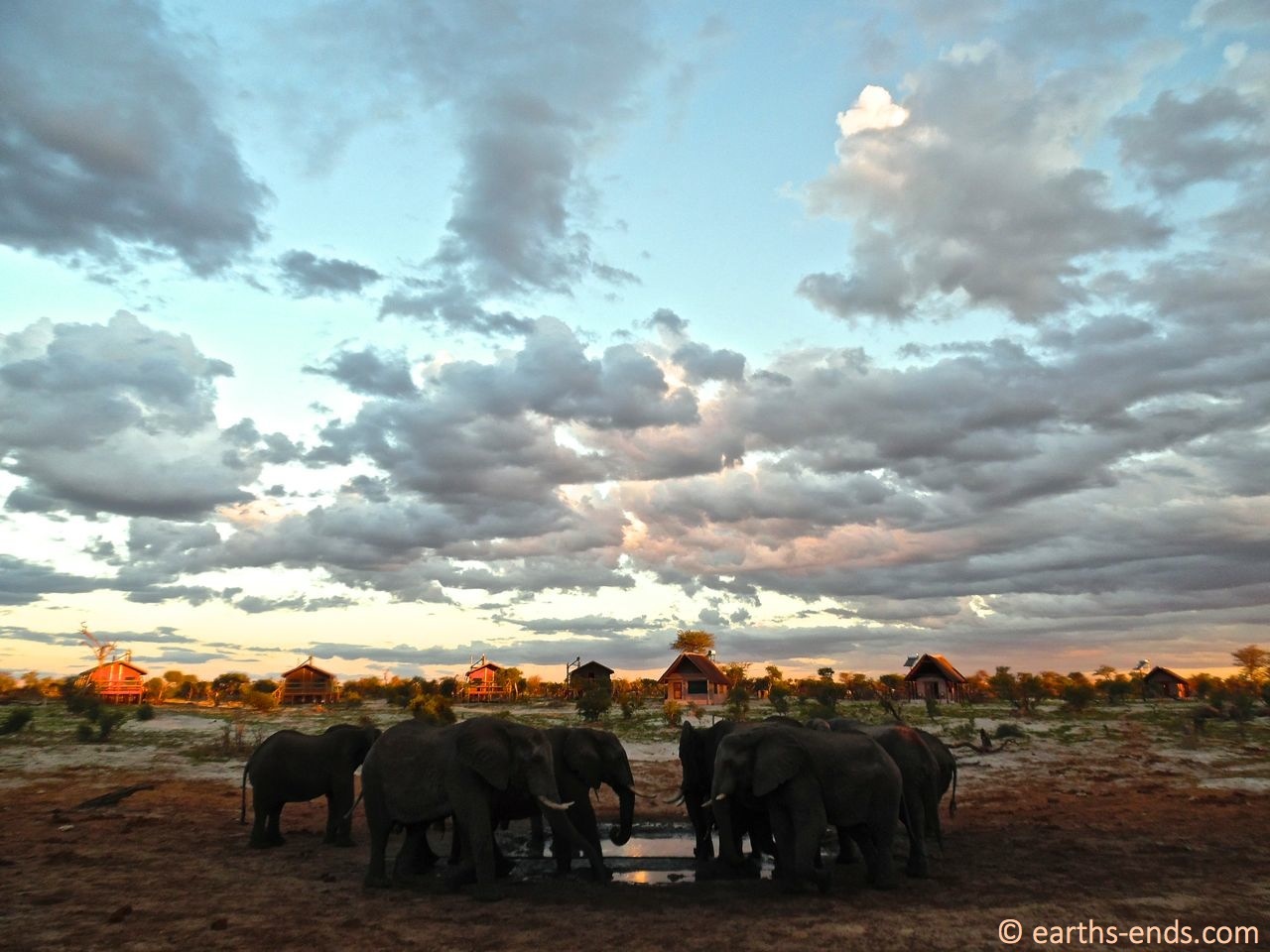
Sunset at the water hole
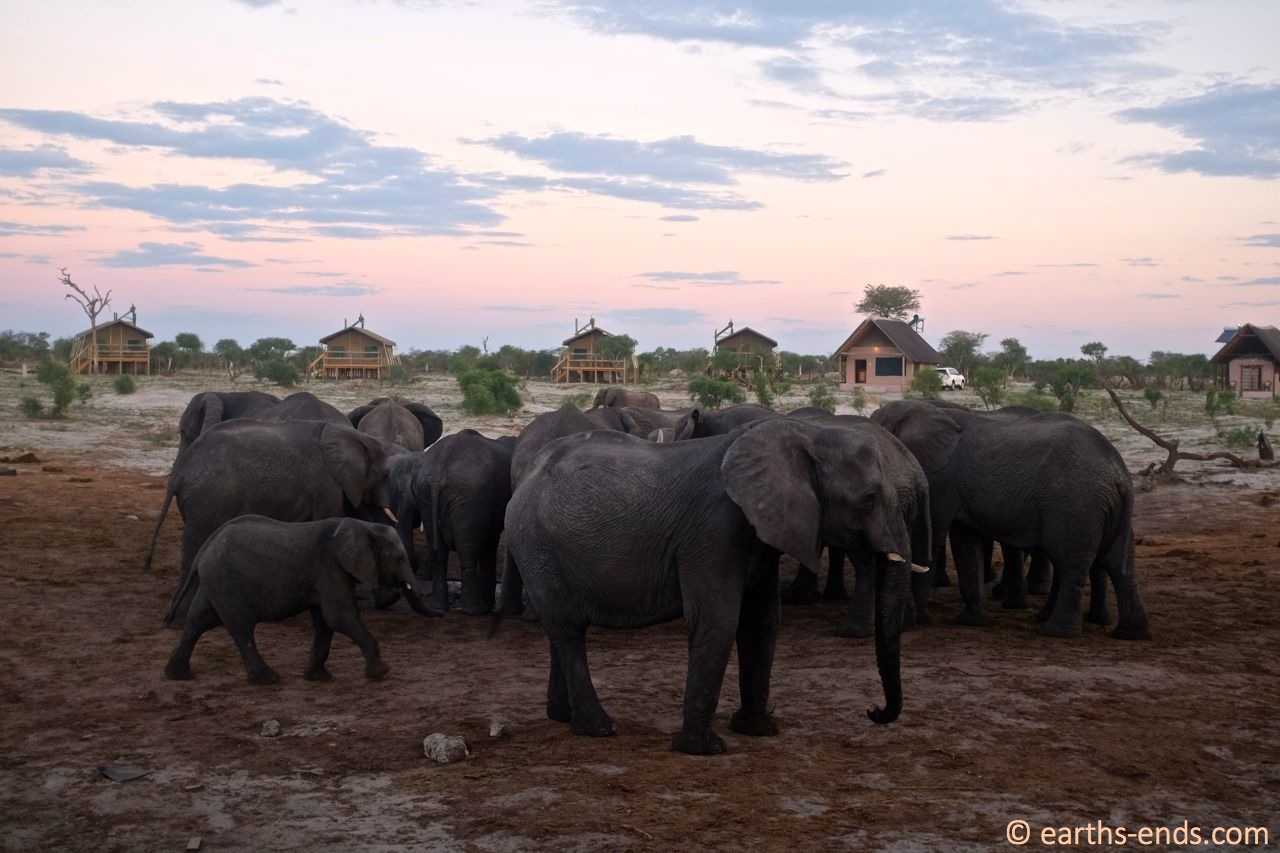
This is the time most of the family groups come along
The ride in was reasonably challenging with soft, deep sand that was particularly chopped up at the end. As I got to reception I was informed by one of the managers that had been watching our ride in, that usually when they hear motorbikes coming the staff go to reception to get a good view of the ensuing carnage. She says the bikers almost always go down in the last section of sand and admitted on seeing a chick on a big bike she thought I for sure was going to crash. I was glad to fly the flag for the lady riders by staying on and apparently making it look easy.

Elephants showing what they think of us staring at them all day
Mick and I have ridden a lot of sand back in Australia including the crossing of over a thousand (literally over a thousand) sand dunes of the Simpson Desert. Yet despite this exposure to sand riding I must say that it NEVER feels good riding it at the time. The level of comfort I feel riding in sand would be the same as if I walked around with a hand grenade in my underpants. Sure, probably nothing bad would happen but it would make for a tense afternoon out and many questions as to why on earth you are putting yourself through it. Riding in sand is like this. I love it like a cold sore.
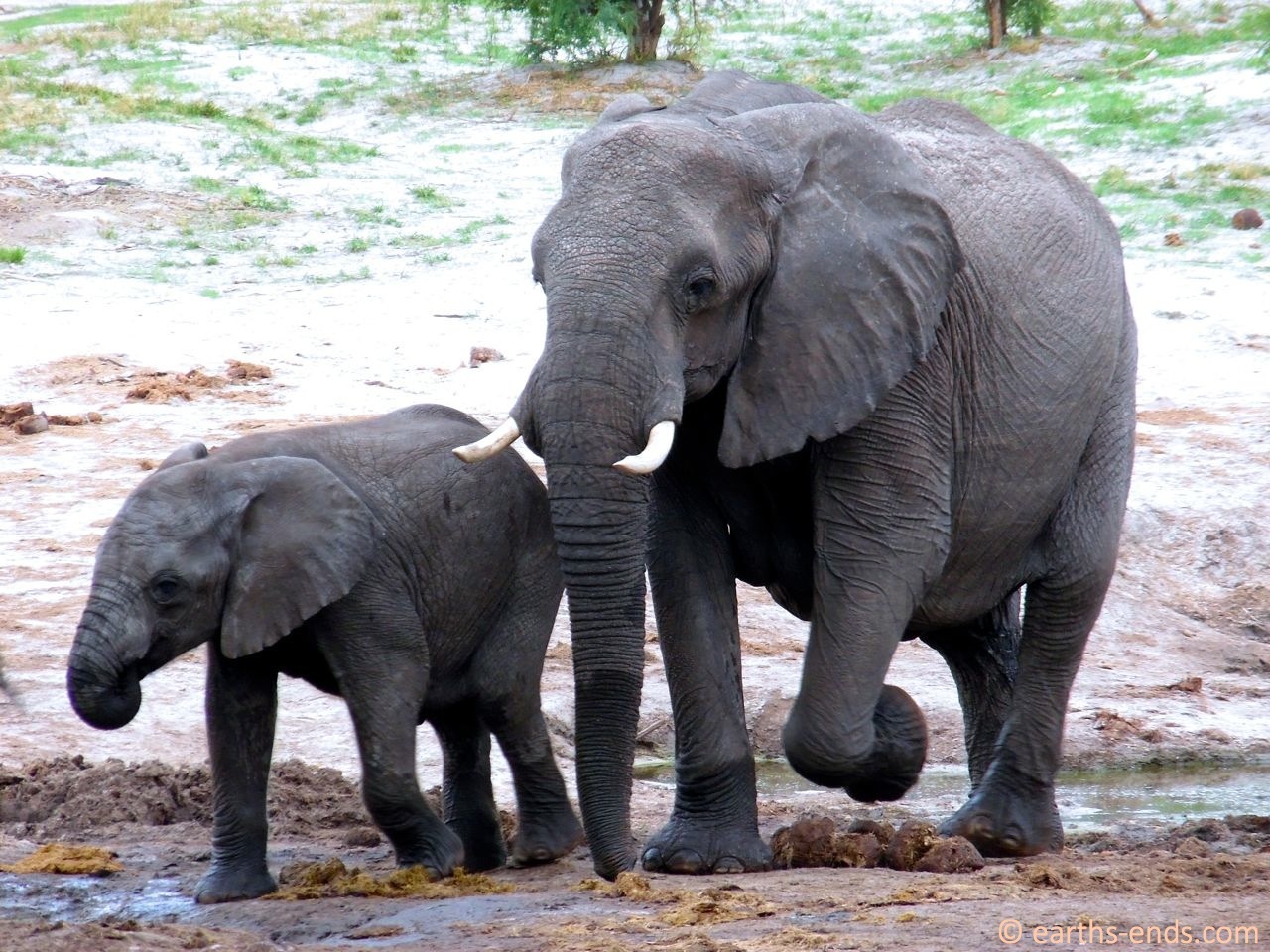
Mum and bub

The young male elephants play fighting

Another mother and young elephant
Arriving at the end of the dry season but before the rains is the best time to see elephants at Elephant Sands, however it is probably the worst time to be camping there. At the end of the dry, countless elephants come from far and wide to drink at the only reliable source of water once everything else has dried up. At this time the pump can barely keep up with dozens of elephants. A grown elephant drinks about 400L of water per day I am told. Some enterprising elephants look for alternative sources of water. First target is the ablution blocks and its pipes. When we got there, the campground looked like a war zone with trees knocked down, a few chalets destroyed, holes everywhere and with only a single toilet and shower still working. The elephants had taken all the doors off the toilets and most of the cisterns and toilet seats too. While most of the damage was done in the noble pursuit of water, there also appears to be an element of curiosity to the destruction with the highly intelligent animals breaking stuff to see what happens. The staff had been referring to the damaged part of the campground as Baghdad and the big bull elephant responsible for the bulk of the damage is known as Saddam. It made for very rustic camping with very limited amenities but you can’t really complain when it is the elephants you come to see that are the ones responsible. We set up camp in amongst the elephant shit and admired the carnage they had wreaked on the camp. We then settled in for some sundowner drinks and to watch the elephants mill about the water trough.

A juvenile
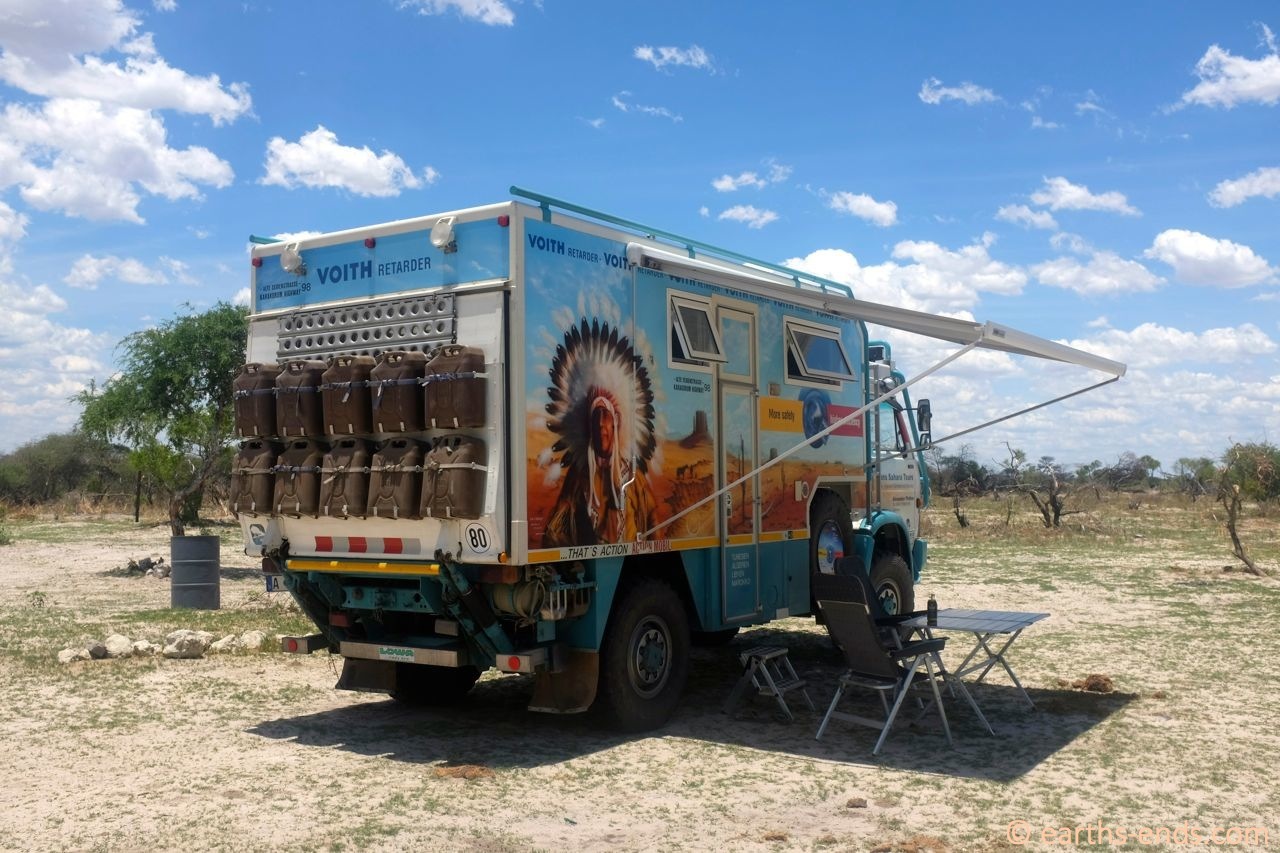
A fellow Overlander doing it in style

An excellent set up – much jealous, many envy
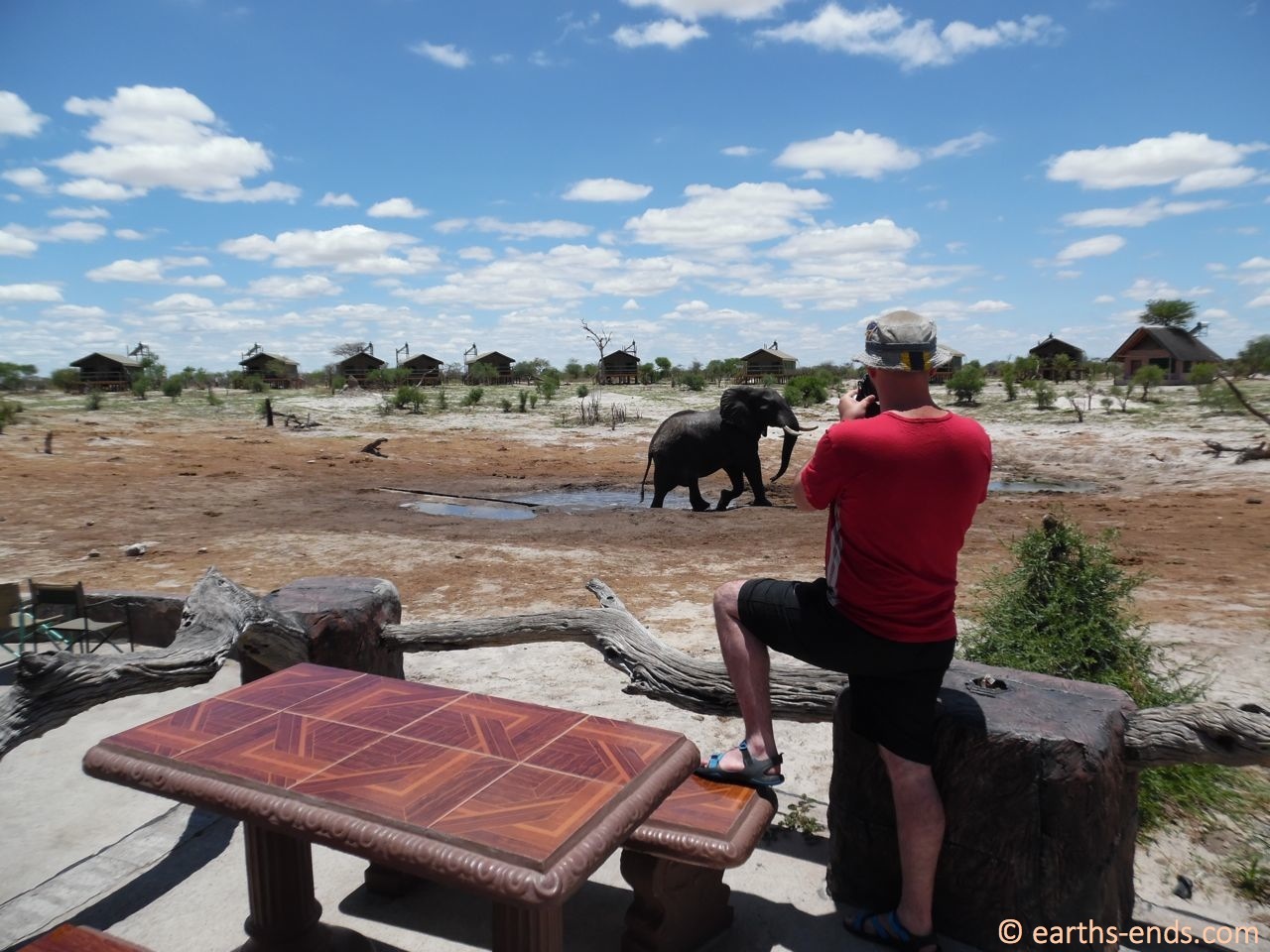
During the heat of the day there is only the odd elephant at the waterhole. The others of off busily eating the 400 odd kilos of vegetation required to get them through the day
It was very interesting watching the complex interplay of personalities and the rigid hierarchy at the water trough. We witnessed human like demonstrations of utter disappointment and frustration on the faces of the elephants that had obviously trekked a long way without any water before arriving at Elephant Sands. When they are within sight of the water hole the let out excited trumpeting and sprint to the edge of the water trough. These creatures can move extremely fast, especially when thirsty. The looks of devastation on their faces is so clear when they get to the trough and are swiftly informed by the king pin elephant throwing his ample weight around, that they are just going to have to wait until they say so for a drink. They looked so much like a worn-out human family at that time. The non-alpha male had to walk back to the family and break the bad news. Wifey elephant is all indignant like ‘What do you mean we can’t drink? What about the kids? What did you say to him? He can’t treat us like this, I’m going to talk to him.’ And non-alpha male is like ‘I said we have to wait goddammit woman!’ Meanwhile the younger ones are getting all stroppy and frustrated and go to the waterhole and get quickly put in their place and run back to the family. Then they all stand there quietly fighting their thirst, staring dejectedly at the elephants drinking until finally a family group leaves and they can see if they can have their turn. It is seriously better than tv, especially at night where things tend to get rowdier at the water hole.
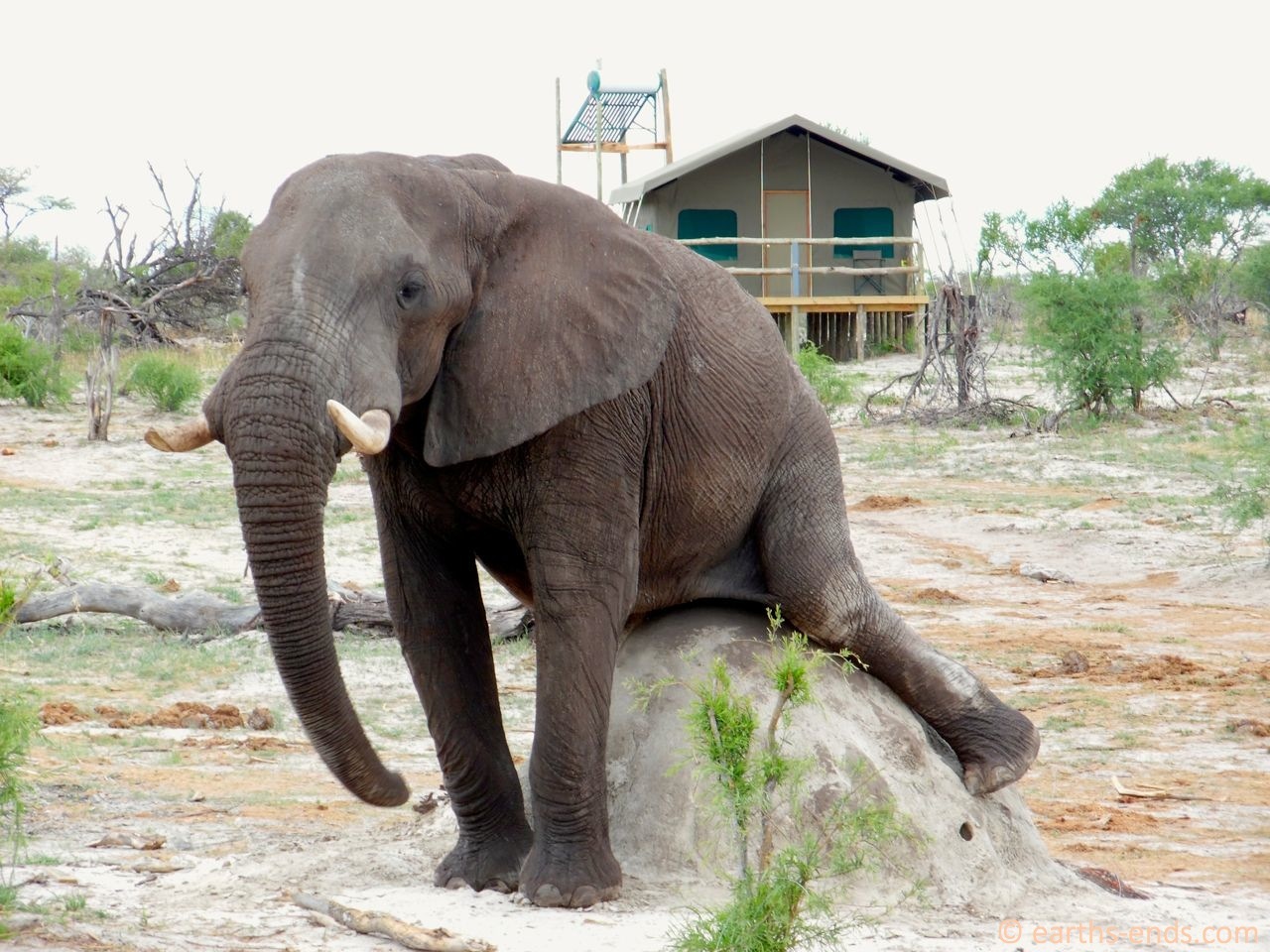
Undoubtedly a male enjoying what looks to be a harty ball scratch
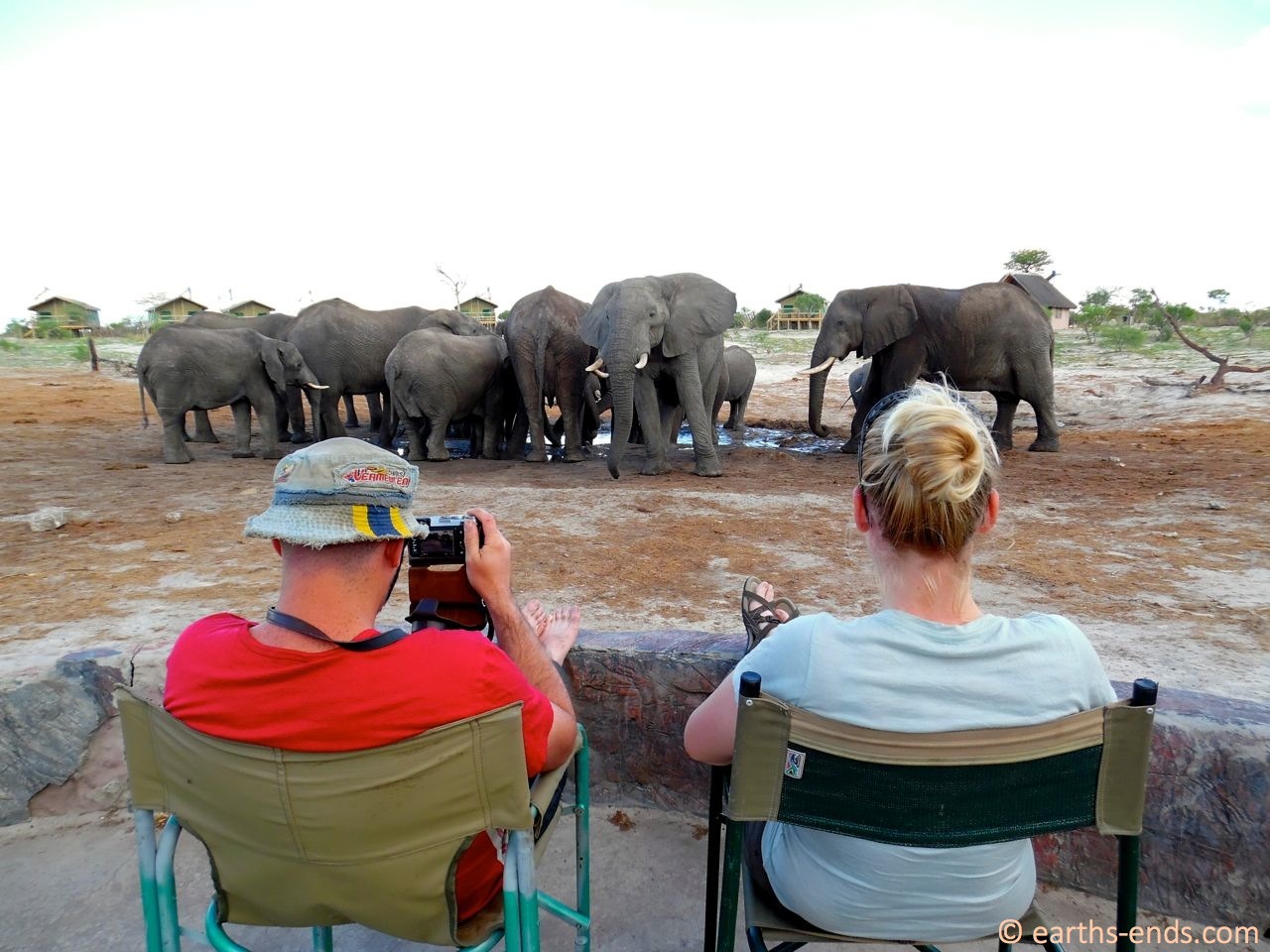
A great way to pass the day
We were happy to find another Aussie biker already settled in at the bar (where else would he be?). Mark had been working in Zambia and is riding around on a KLR while he sorts out some visa issues. It was great talking with a fellow Aussie and biker and we passed the couple of days chilling out by the elephants, eating toasted sandwiches and shooting the breeze.
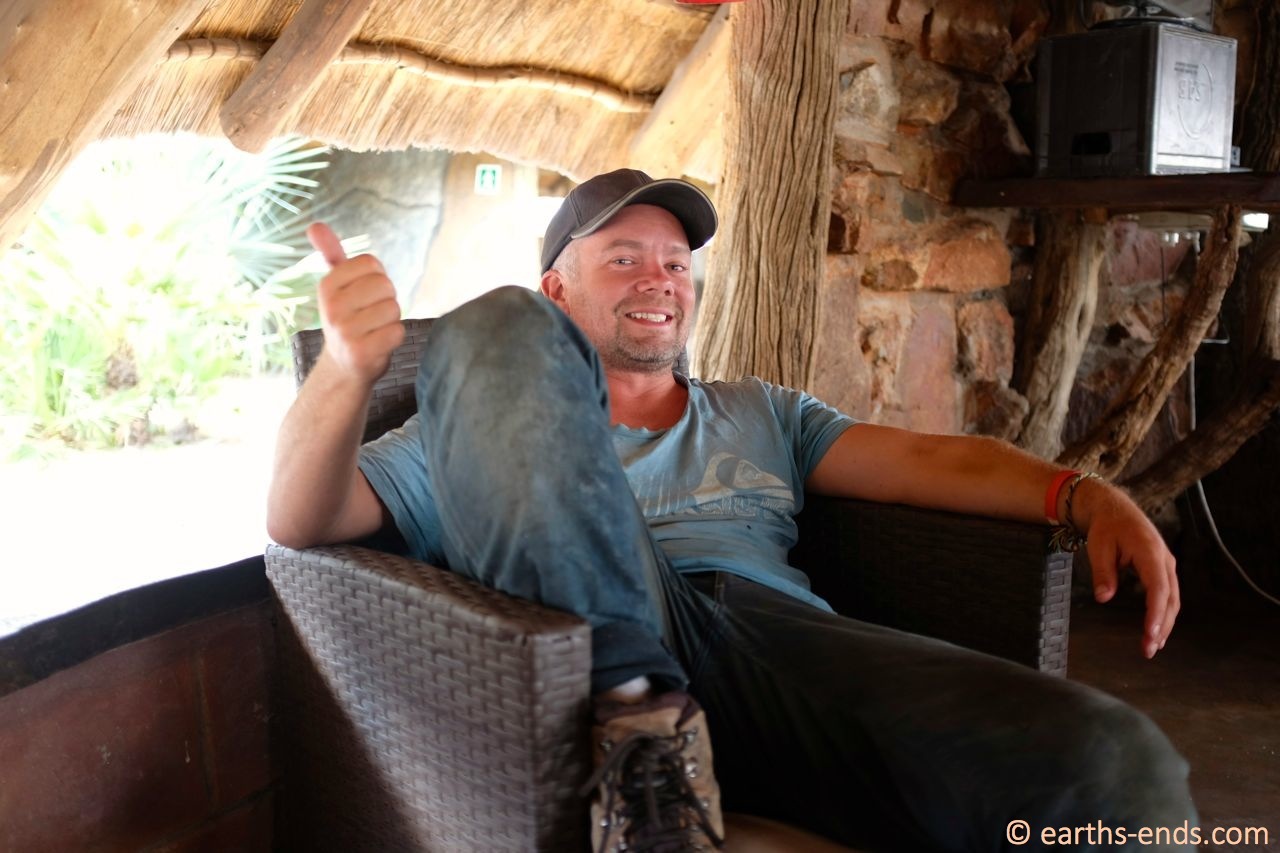
Aussie Mark the KLR pilot

We heard the sounds of a elephant in distress all through the night. The next day we saw this little fella

About 12 hours old at a guess
That night, I woke up to the quiet sounds of an elephant walking around our tent. Looking up I could make out the tip of his trunk at the top of our tent sniffing and investigating what was going on in the strange green fabric dome. This was all well and good and not too much of a worry as he was clearly just being curious. I can’t say it enough, elephants are very inquisitive and intelligent animals. However the next night was very different.
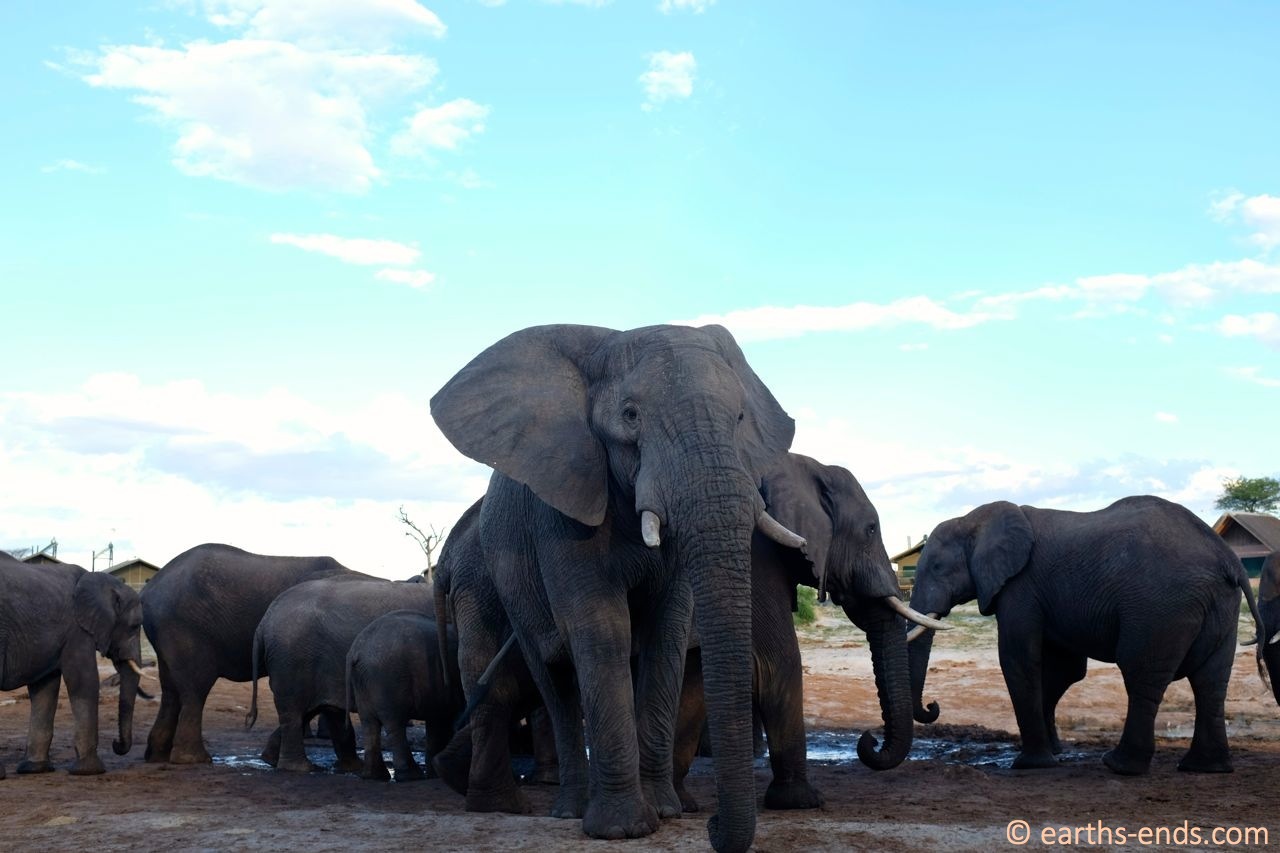
King Pin keeping an eye on the tourists
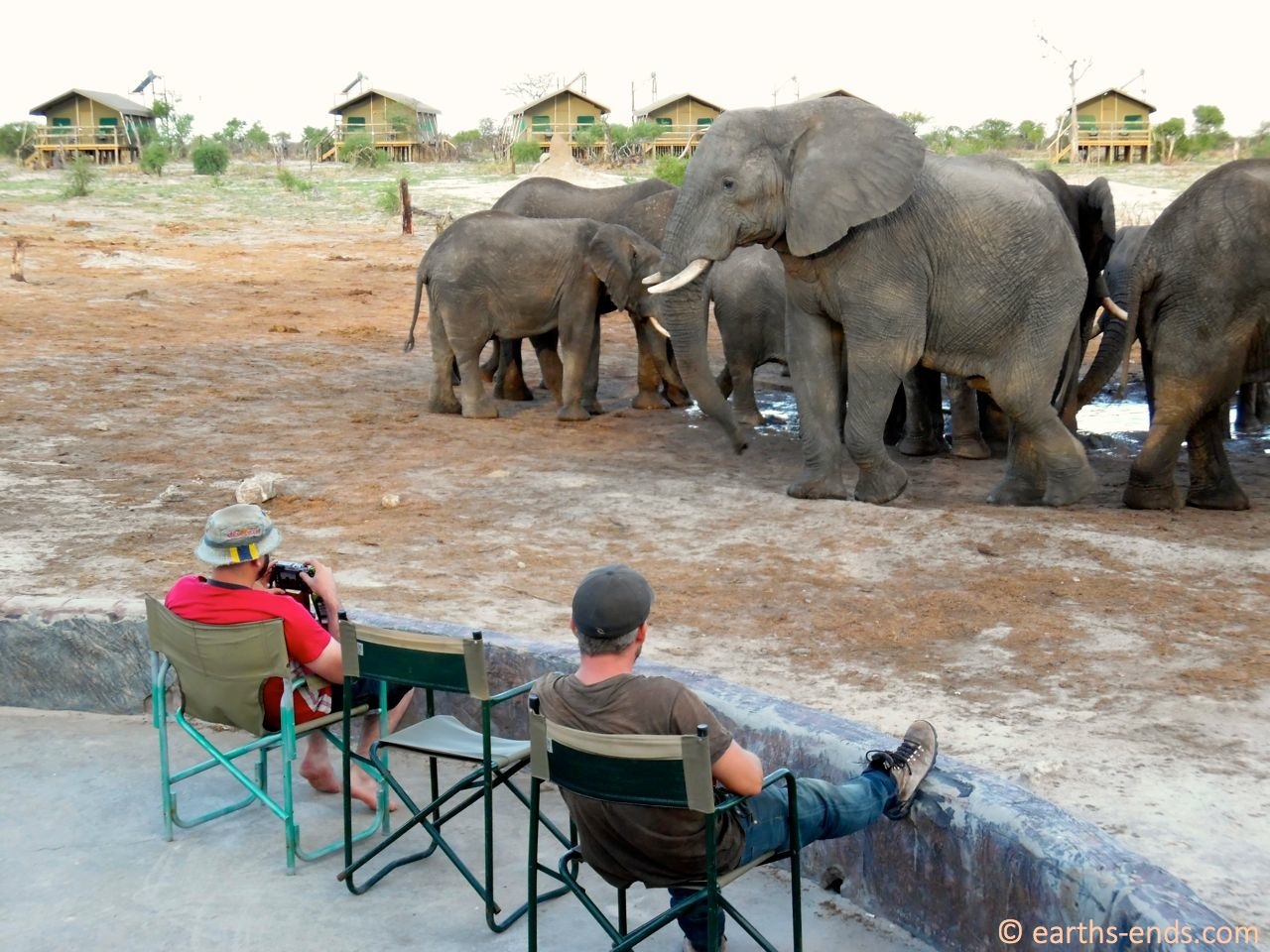
This guy was huge
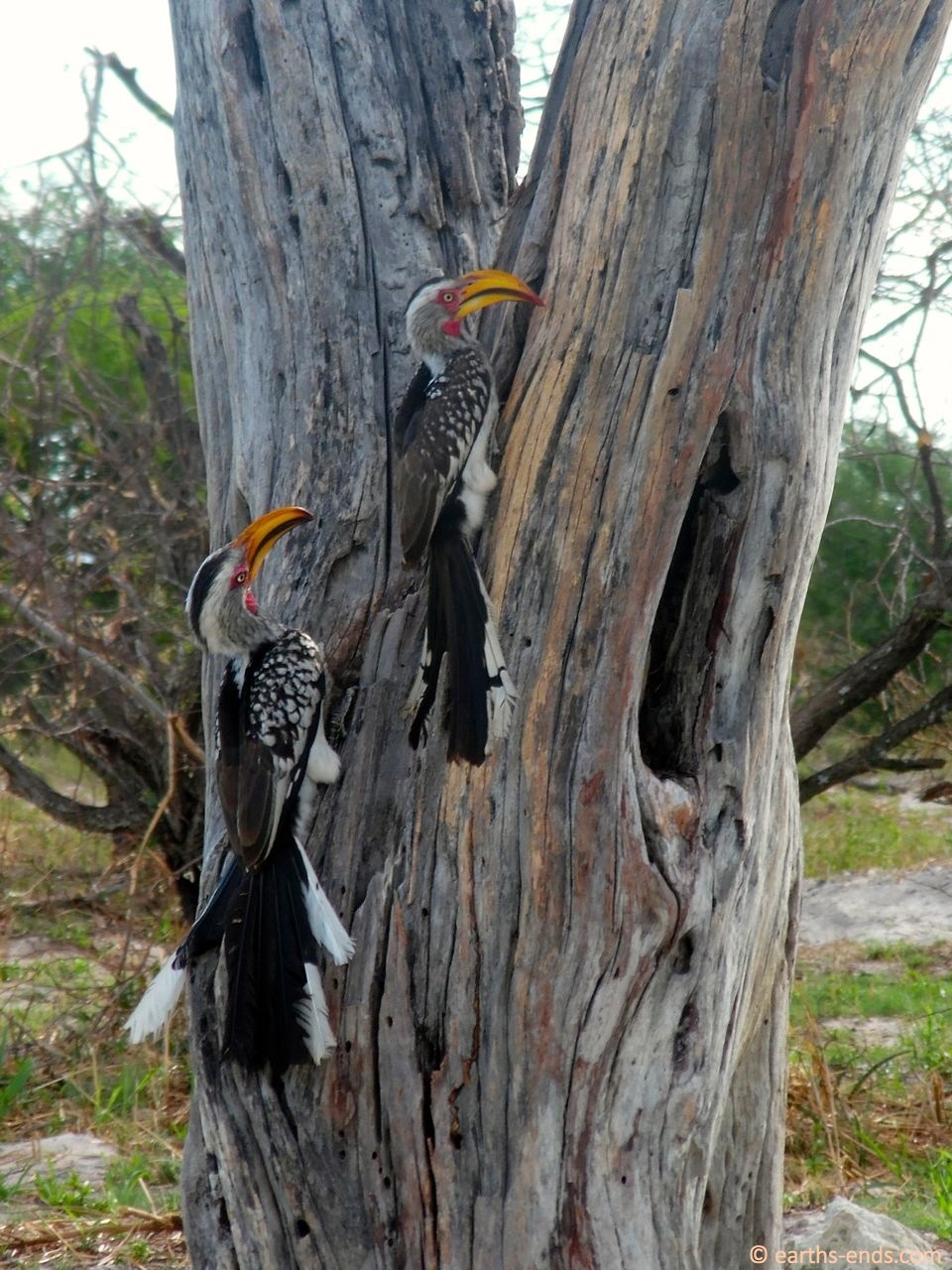
These hornbills are generally hard to photograph but these two were right outside our tent carrying out a raid on another bird’s nest

Tyre change interrupted by marauding elephants
The Elephants enjoying the drink by the pool
We woke in the middle of the night to a deep guttural growling sound coming from all around our tent. To my untrained foreigner ear it sounded like lions that had obviously come to eat us. We were aware that there were lions that lived about 15km from the camp. It was conceivable to me that at the end of the dry season they might well come closer. You could sense a lot of tension in the air and the growling sound just continued until the point I decided that I really wanted to be back in Australia dealing with our home grown deadly animals rather than these unfamiliar African ones. In the end Mick was able to see that it was a group of elephants in the campground responsible for the noise which made me relax slightly until I started to imagine what it was that was making the generally chilled out elephants make such a racket. I thought there might be lions scaring the elephants but the next day this theory was met with the mocking laughter of my fellow tourists. Vindication came after we had left and lions were indeed seen wandering around the camp. I don’t imagine that people were laughing when that happened!

Mick discovering skills he never knew he had
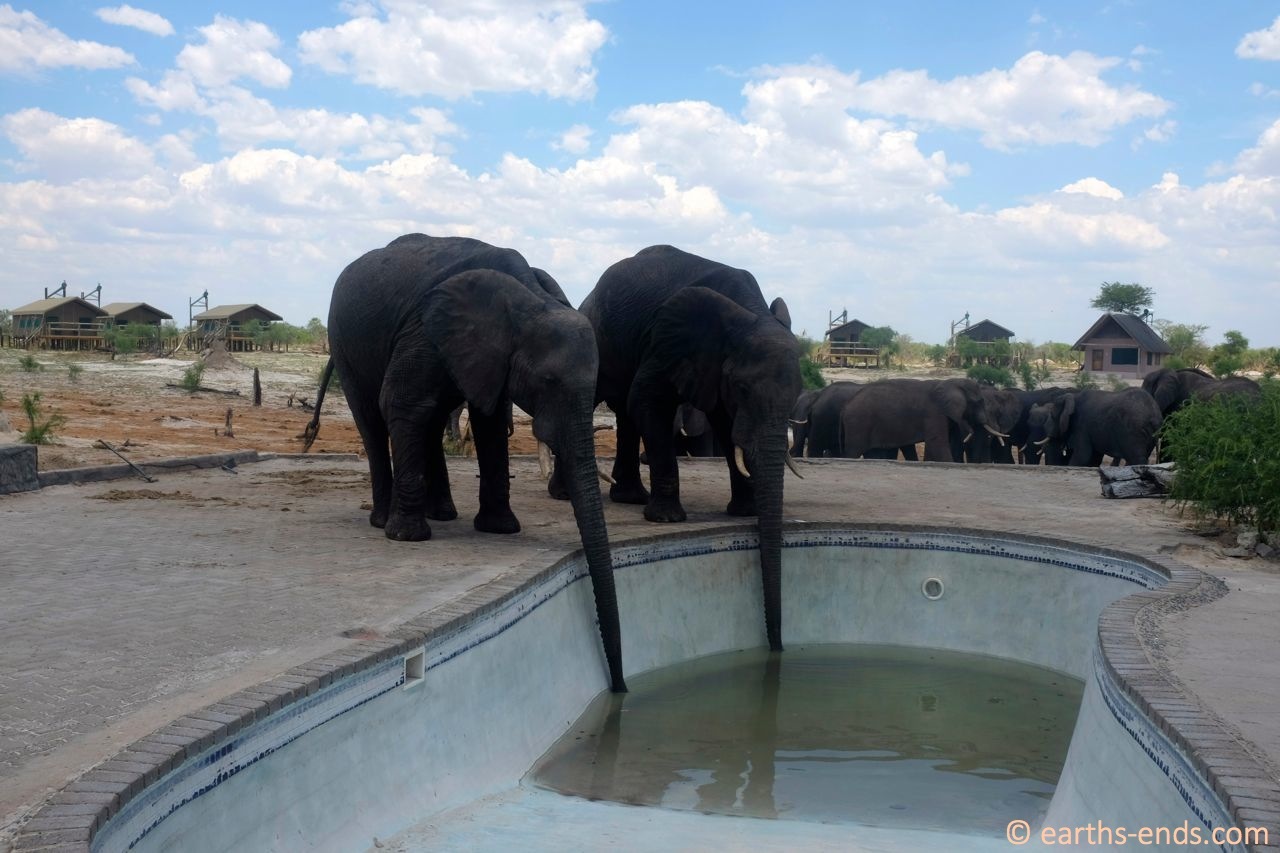
Drinking the pool dry
The next day we were excited by the unexpected arrival of a series of motorbike riders. Ido the Israeli guy we had dinner with at Ai Ais in Namibia showed up with Alan (an Italian) and his Dutch girlfriend Ireen who were riding two up on a BMW F800GS. We were extremely impressed to see they made in through the sand track without stacking it. Next came two Belgians, Gabriel and Peter, who were both on BMW R1200GSAs. We had seen these guys at Ai Ais also but were leaving as they arrived so only managed to wave a hello before hitting the road. It was great and rather surprising to get the chance to talk with them here in Botswana. And just when the proprietors were no doubt worried that they were the unfortunate hosts of an unscheduled motorcycle meet, three German guys (one on BMW other 2 on Africa Twins) joined the motely crew of bikers.
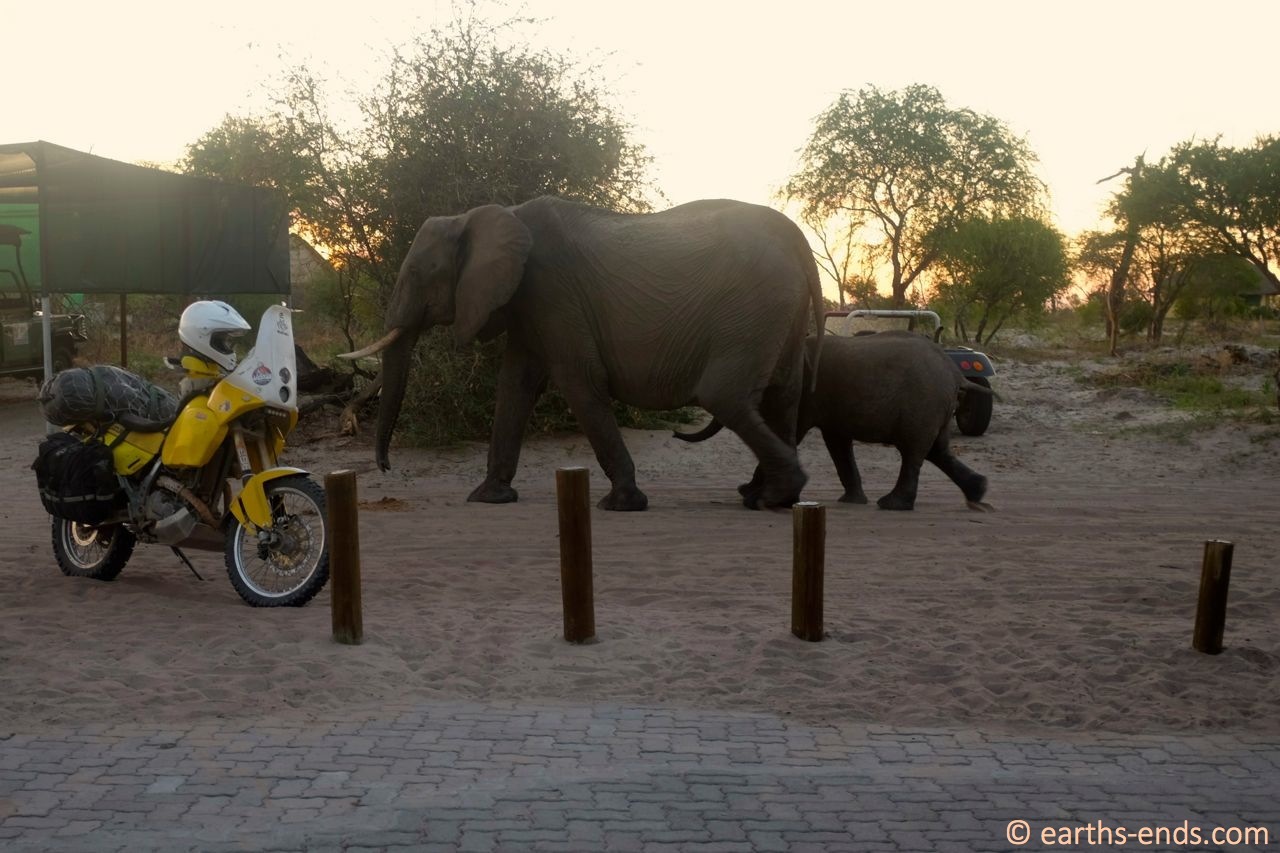
A mum and baby checking out the DR
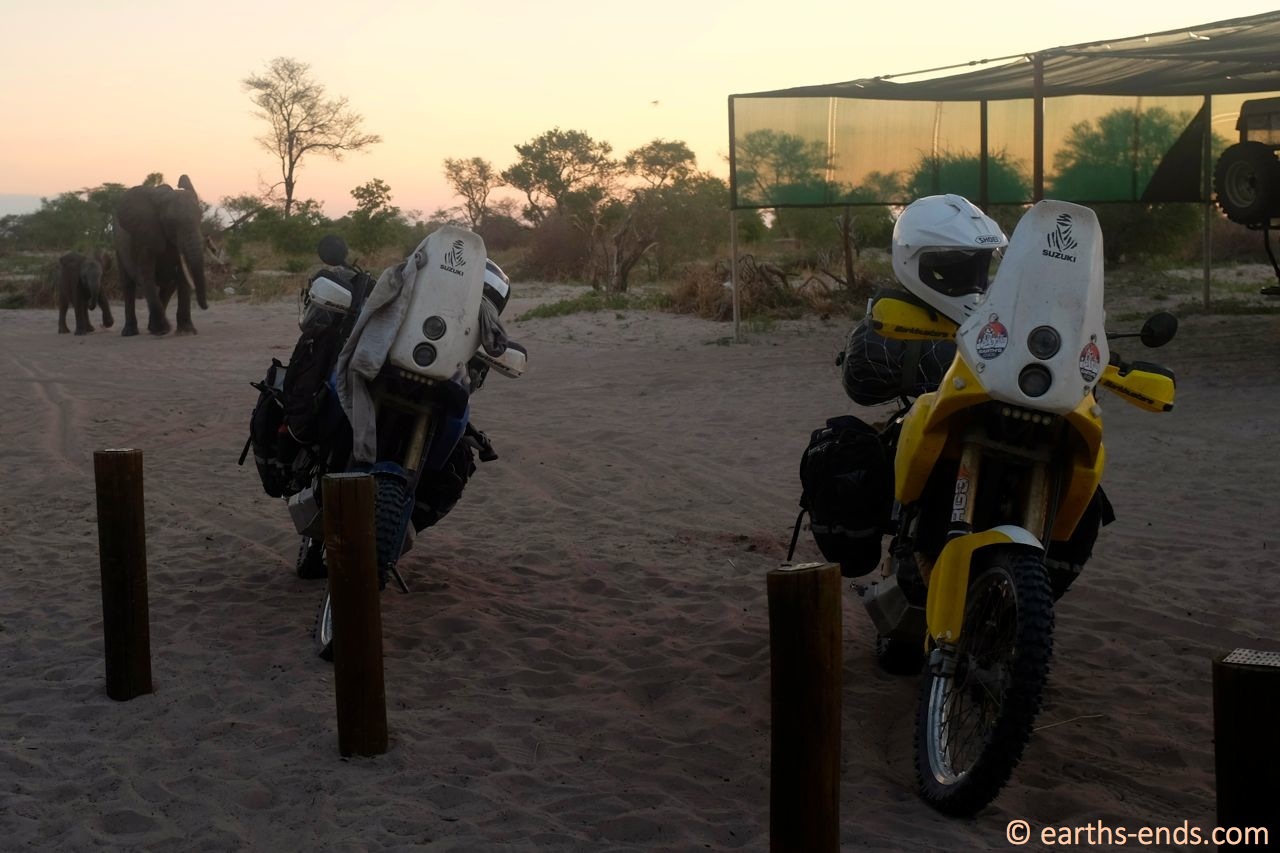
Riding bikes in Africa – pretty excellent
We barely ever see other overland bikers during our travel and here we were inundated with like-minded individuals, full of advice and tips for the roads ahead. The best part of meeting other bikers is the elaborate ritual of motorbike show and tell that ensues. We love seeing what gear everyone else is running and carrying. That night we had the idea of inviting all the bikers we could on our upcoming trip to the salt pans….’What could go wrong?’ we said……’It will be fun’ we said……
 Earths-Ends
Earths-Ends
Wow, elephants and more elephants, baby ones and big daddy ones and ones that want to get into bed with you. Incredible experience…